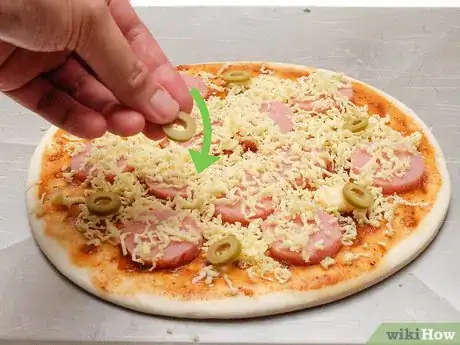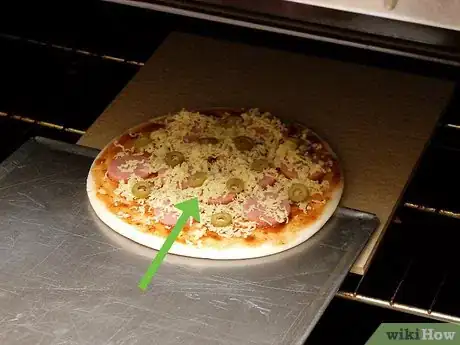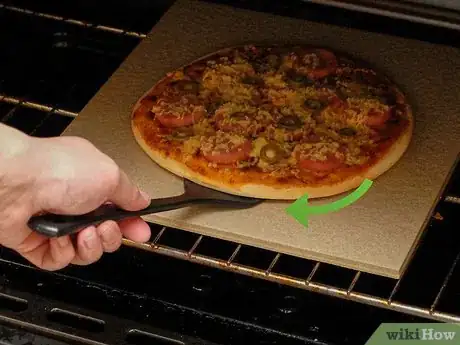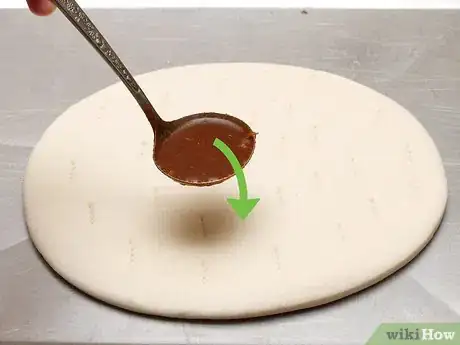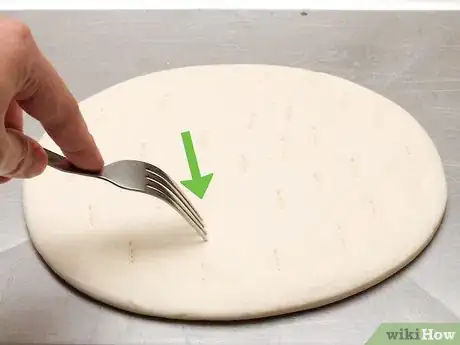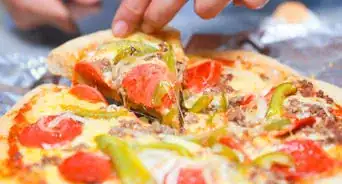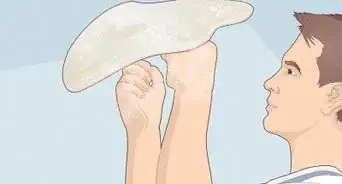This article was co-authored by wikiHow Staff. Our trained team of editors and researchers validate articles for accuracy and comprehensiveness. wikiHow's Content Management Team carefully monitors the work from our editorial staff to ensure that each article is backed by trusted research and meets our high quality standards.
There are 12 references cited in this article, which can be found at the bottom of the page.
wikiHow marks an article as reader-approved once it receives enough positive feedback. In this case, 92% of readers who voted found the article helpful, earning it our reader-approved status.
This article has been viewed 141,375 times.
Learn more...
Gas ovens tend to become inaccurate and uneven as they age, making precise baking difficult. The laws of pizza are straightforward to learn, though, even if accomplishing them can be difficult in a home oven. Crank the heat as high as possible, and bake the pizza on a surface that can retain plenty of heat. Even if your first pie doesn't turn out perfect, you can usually adjust for better results with a few simple tactics.
Steps
Cooking Pizza
-
1Put in a pizza stone if you have one. This one change can make a huge difference. Gas ovens often have less even heat and more moisture than electric ovens. A preheated pizza stone heats your food faster and more evenly, and draws out moisture to prevent soggy crusts.[1] [2] Place it on the lowest or second-lowest rack, or wherever you usually bake your pizzas.
-
2Preheat the oven to its maximum temperature. Professional pizza ovens are much hotter than anything in your kitchen. Crank the oven up to the highest setting — at least 500ºF (260ºC). A pizza stone or heavy cast-iron pan takes longer to heat than your oven, so wait at least 30 minutes.[6]
- A large pizza stone may need 40–60 minutes. If you want to be sure, check with an infrared thermometer.
Advertisement -
3Build your pizza. Place your homemade pizza dough on a pizza peel dusted with flour or cornmeal to prevent sticking. Pound the dough into a disk and form the lip of the crust by hand.[7] Toss or pull your pizza until it reaches the desired thickness and size. Brush the lip of the crust with olive oil and add all the toppings.
- If you don't have a pizza peel, use a rimless baking sheet or an upside-down rimmed sheet, with floured parchment paper over it.[8]
-
4Slide the pizza onto the cooking surface. Shake the pizza peel or baking sheet gently to unstick the dough. Place the end of the pizza peel onto the cooking surface and jiggle it so the pizza starts to slide off. Once the end of the pizza is flat on the stone, jerk the peel back quickly to drop the rest of it.[9]
- The preheated stone or pan is extremely hot, so be careful.
- If using a parchment-lined baking sheet, you'll get better char if you slide the pizza off the parchment paper and cook directly on stone or metal. If your pizza is messy with toppings, though, picking up the parchment and dropping it onto the cooking surface is an easier option.
-
5Start checking the pizza after five minutes. If you normally bake your pizzas at a lower temperature, don't rely on your recipe's time estimate. Most homemade pizza only takes 8–12 minutes at 500 to 550ºF (260–285ºC). Take yours out when the top is bubbling and the crust has browned.
-
6Rotate the pizza if your oven cooks unevenly. If your oven has issues with hot spots, rotate the pizza 90 degrees halfway through baking to help it brown evenly.[10] This usually isn't necessary if you are using a pizza stone (and allowed enough time for it to preheat), since the stone's radiant heat should make up for your oven's shortcomings.
- Do this quickly to minimize heat loss.
-
7Take the pizza out of the oven. Slide the pizza off the pizza stone or pan and onto a plate or cooling rack. Let cool for a couple minutes before cutting.
- Check the underside of the crust before you remove it. The ideal crust is well-browned, with a few spots of char. If the crust is still pale, let it bake a couple minutes longer.
Troubleshooting Baking Issues
-
1Switch to a different rack if the top and bottom cook at different rates. In a base-heated oven, the crust will cook faster the lower it is. The top of the pizza cooks faster closer to the ceiling, mostly due to faster air currents.[11] Use a lower rack next time if you've been getting brown, bubbly cheese over a pale, doughy crust. Move the pizza to a higher rack if the crust ended up crisper or more charred than you prefer.
- All ovens are a bit different, so you might get different results, especially if your oven heats from the back or ceiling.
- Some people even place their pizza stone directly on the floor of the oven, instead of on a rack. This will make an extra-crisp crust, but some pizza stones will crack under that much heat.
-
2Double bake the crust if you can't get it crisp. If your oven runs cold or you prefer a thick crust, it can be difficult to bake the crust completely without burning the toppings. Try baking the pizza for a few minutes with only the sauce, then adding the other toppings and finishing the job.[12]
-
3Cut back on wet ingredients. If your dough is still turning out underdone, use less sauce or switch to a drier cheese. If your oven is particularly cold or uneven, you may need to use less moisture in your dough.
-
4Prick holes to prevent giant bubbles. Thin, cracker-crust dough can bubble excessively. Poke the center of the dough several times with a fork to make holes for air to escape through.[13]
-
5Protect easily burned toppings with cheese. If delicate leafy greens, garlic, or thin slices of meat turn black and bitter, it's not necessarily your oven at fault. These toppings burn easily. Place them under the cheese or under other ingredients to prevent this.
-
6Spread out toppings if the center is underdone. If the crust is perfect but the toppings need more time, make sure the toppings are spread in a thin, even layer.
-
7Finished.
Community Q&A
-
QuestionHow do I make pizza toppings from vegetables?
 Community AnswerYou can use practically any vegetable, sliced or chopped into thin pieces. Put them on the pizza raw, or grill them for a few minutes first. Only dense vegetables like squash and root vegetables need to be cooked completely before baking on a pizza. Here are a few recipes to try.
Community AnswerYou can use practically any vegetable, sliced or chopped into thin pieces. Put them on the pizza raw, or grill them for a few minutes first. Only dense vegetables like squash and root vegetables need to be cooked completely before baking on a pizza. Here are a few recipes to try. -
QuestionHow do I bake a cake in a gas oven?
 Community AnswerA gas oven works like any other oven. You simply follow the directions for the cake and set the proper temperature on the oven.
Community AnswerA gas oven works like any other oven. You simply follow the directions for the cake and set the proper temperature on the oven. -
QuestionWhat if I use an oven tray; how long will it take to cook and at what temperature?
 Carolina Melo MoreiraCommunity AnswerAbout 350F (180C) for 20 minutes or when the cheese melts. If the dough is precooked, the time may be shorter.
Carolina Melo MoreiraCommunity AnswerAbout 350F (180C) for 20 minutes or when the cheese melts. If the dough is precooked, the time may be shorter.
Warnings
- Only check on the pizza when necessary. Opening the oven door lets a lot of heat escape.⧼thumbs_response⧽
- Some silicone baking sheets may not be safe to use at high temperatures.[15] Check the product information or switch to a metal or stone surface.⧼thumbs_response⧽
- Use the main oven setting (floor heat source), not the broiler (ceiling heat source). A broiler will overcook the pizza toppings and leave the crust underdone. If your oven does not have a ceiling heat source, then the broil setting instead keeps the oven on constantly instead of maintaining a specific temperature — a good setting for pizza.[16]⧼thumbs_response⧽
- Rapid temperature change can break a pizza stone. Always put the pizza stone into the oven before preheating, and leave it in afterward to cool down. Thaw frozen pizza dough before putting it on the hot stone.[17]⧼thumbs_response⧽
Things You'll Need
- Pizza stone, food-safe terra cotta tiles, or cast iron pan
- Pizza peel or parchment-lined baking sheet
- Cornmeal or flour
- Pizza dough & toppings
References
- ↑ http://www.thekitchn.com/5-important-things-to-know-about-baking-in-a-gas-oven-226270
- ↑ http://www.goodeatsfanpage.com/season3/pizza/pizzatranscript.htm
- ↑ https://whatscookingamerica.net/History/Pizza/Pizzahintstips.htm
- ↑ http://articles.latimes.com/1987-11-22/travel/tr-23510_1_cadmium
- ↑ http://slice.seriouseats.com/archives/2011/06/the-best-surface-for-baking-pizza-finale.html
- ↑ http://altonbrown.com/pizza-dough-recipe/
- ↑ http://altonbrown.com/pizza-dough-recipe/
- ↑ https://food52.com/hotline/5467-what-s-the-best-way-to-get-dough-onto-a-pizza-stone-without-a-peel
- ↑ http://altonbrown.com/pizza-dough-recipe/
- ↑ http://www.thekitchn.com/5-important-things-to-know-about-baking-in-a-gas-oven-226270
- ↑ http://slice.seriouseats.com/archives/2011/02/which-oven-rack-should-i-put-my-pizza-stone-on.html
- ↑ http://cooking.stackexchange.com/questions/34779/homemade-pizza-getting-the-dough-crispy
- ↑ https://whatscookingamerica.net/History/Pizza/Pizzahintstips.htm
- ↑ http://www.thekitchn.com/5-important-things-to-know-about-baking-in-a-gas-oven-226270
- ↑ http://www.thekitchn.com/want-the-best-homemade-pizza-you-have-to-turn-up-the-heat-163038
- ↑ http://slice.seriouseats.com/archives/2011/02/which-oven-rack-should-i-put-my-pizza-stone-on.html#comments-137206
- ↑ http://www.bakingsteel.com/blog/why-pizza-stone-cracked


